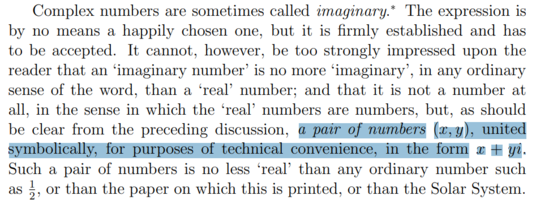MaxMath
Junior Member
- Joined
- Mar 22, 2023
- Messages
- 90
I'm intrigued by this paragraph of this book of Hardy (page 113 of pdf). Before this point of discussing complex numbers in a way familiar to most people, Hardy made a great effort to discuss "displacement", or a pair of real numbers. Particularly, he patiently showed the reader what the best way is to define the product of two displacements (or pairs of numbers). After lengthy discussions, Hardy now says—a complex number, in the form of x+yi, is merely a "technical" form of expressing a pair of two numbers. He also says—a complex number, or an imaginary number, is by no means less 'real' than an ordinary real number.
This may not be something revolutionary. But it is indeed very different from how complex number was introduced to me. While I hope I can find some clue when I read on, I really want to hear from people who study math as their major, or who are actually mathematicians, about why so much stress needs to be put on the fact that a complex number is only a pair of numbers. Why is this so important? He also seems to suggest that the word "imaginary" is probably not a very good term (and likewise "real").
This may not be something revolutionary. But it is indeed very different from how complex number was introduced to me. While I hope I can find some clue when I read on, I really want to hear from people who study math as their major, or who are actually mathematicians, about why so much stress needs to be put on the fact that a complex number is only a pair of numbers. Why is this so important? He also seems to suggest that the word "imaginary" is probably not a very good term (and likewise "real").

